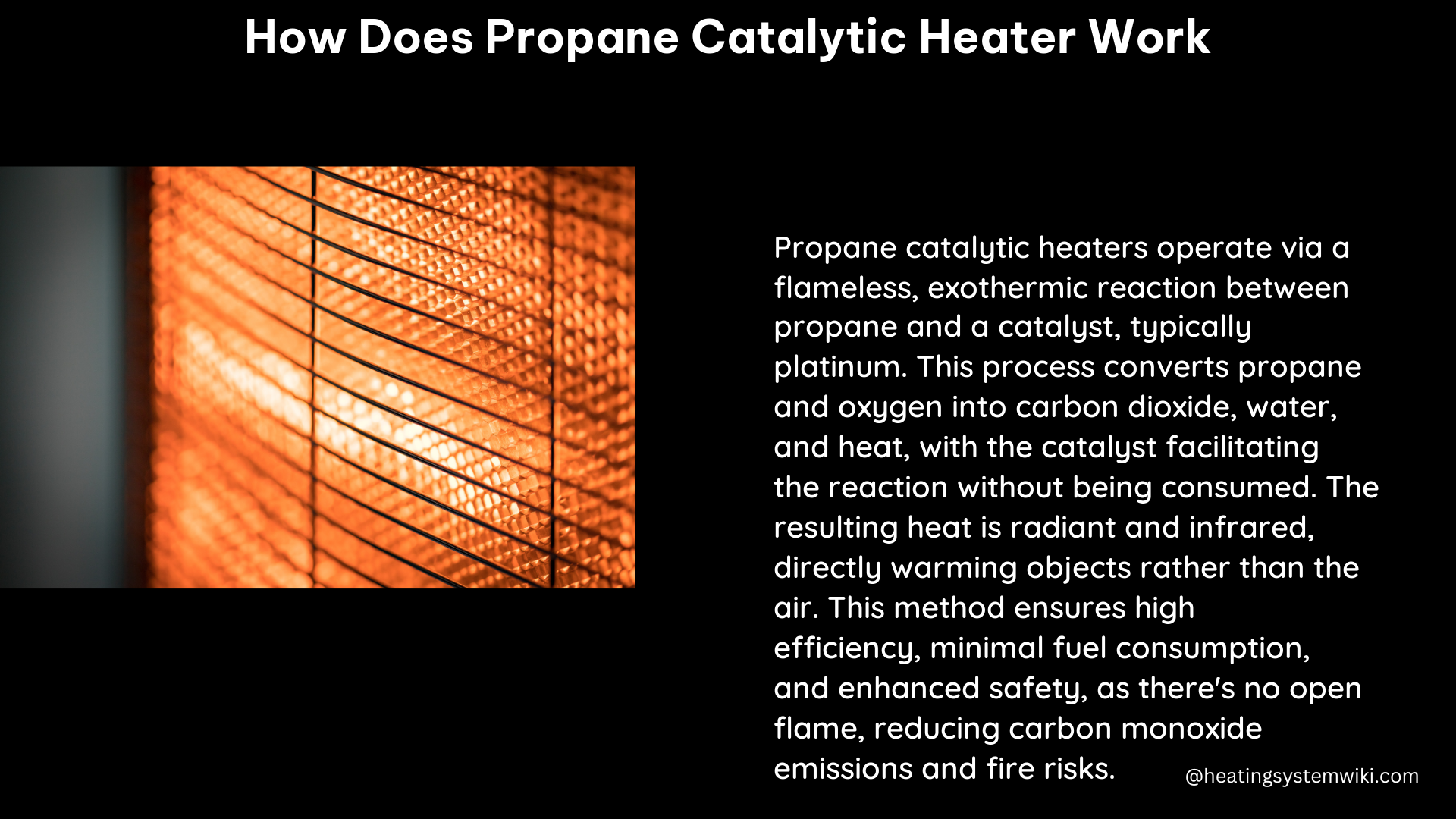A propane catalytic heater is a unique and efficient heating solution that utilizes a catalyzed chemical reaction to produce heat without the need for a flame. This flameless heating technology offers a range of benefits, including enhanced safety, improved energy efficiency, and reduced environmental impact.
The Catalytic Reaction: The Heart of Propane Catalytic Heaters
At the core of a propane catalytic heater is a catalytic reaction that breaks down propane molecules and converts them into heat. The catalyst, typically made of platinum or palladium, plays a crucial role in this process by providing an alternative reaction pathway with lower activation energy.
When propane molecules come into contact with the heated catalyst surface, they undergo a chemical transformation. The catalyst facilitates the oxidation of propane, where the propane reacts with oxygen to form carbon dioxide and water vapor. This exothermic reaction releases heat, which is then radiated outward from the heater’s surface.
The key advantage of this catalytic reaction is that it occurs at much lower temperatures compared to traditional combustion-based heating methods. Typically, a propane catalytic heater operates at temperatures between 300°C to 500°C (572°F to 932°F), significantly lower than the 1,100°C to 1,500°C (2,012°F to 2,732°F) required for open-flame combustion.
Technical Specifications and Components

A propane catalytic heater is composed of several essential components:
-
Fuel Source: The heater requires a reliable source of propane fuel, typically stored in a pressurized tank or cylinder.
-
Catalyst: The catalyst, usually a platinum or palladium-coated surface, is the heart of the heater. It facilitates the catalytic reaction that converts propane into heat.
-
Electrical Preheating System: An electrical heating element is used to preheat the catalyst to the required operating temperature, typically between 300°C to 500°C (572°F to 932°F).
-
Thermostat and Controls: The heater is equipped with a thermostat and control system to regulate the heat output and maintain the desired temperature.
-
Enclosure and Reflector: The heater’s enclosure and reflector are designed to efficiently distribute the radiant heat generated by the catalytic reaction.
The specific technical specifications of a propane catalytic heater can vary depending on the manufacturer and the intended application. However, some common performance characteristics include:
- Heat Output: Ranging from 1,500 to 30,000 BTU/h (0.44 to 8.8 kW) or more, depending on the heater’s size and design.
- Fuel Consumption: Typically between 0.1 to 2.0 gallons (0.38 to 7.6 liters) of propane per hour, depending on the heat output.
- Efficiency: Catalytic heaters can achieve thermal efficiencies of 90% or higher, making them highly efficient compared to traditional heating methods.
- Operational Life: With proper maintenance, a well-designed propane catalytic heater can have a lifespan of 10 to 15 years or more.
Safety Considerations and Installation
Propane catalytic heaters are designed to be inherently safe, with the absence of an open flame eliminating the risk of accidental fires and burns. However, it is essential to follow proper safety guidelines and manufacturer instructions during installation and operation.
Key safety considerations include:
- Ventilation: Ensure adequate ventilation to prevent the buildup of carbon monoxide and other combustion byproducts.
- Placement: Avoid using the heater in enclosed spaces and maintain a safe distance from flammable materials.
- Maintenance: Regularly inspect and clean the heater to ensure optimal performance and safety.
- Fuel Handling: Handle propane fuel with care, following all local regulations and manufacturer guidelines.
When installing a propane catalytic heater, it is crucial to consult the manufacturer’s instructions and adhere to all local building codes and safety regulations. If you are unsure about any aspect of the installation process, it is recommended to seek the assistance of a professional installer or the manufacturer’s customer support team.
Advantages of Propane Catalytic Heaters
Propane catalytic heaters offer several advantages over traditional heating methods:
- Flameless Operation: The absence of an open flame eliminates the risk of accidental fires and burns, making them a safer choice for a wide range of applications.
- Energy Efficiency: Catalytic heaters can achieve thermal efficiencies of 90% or higher, resulting in significant energy savings and reduced fuel consumption.
- Environmental Friendliness: Catalytic heaters produce lower emissions compared to traditional combustion-based heaters, making them a more eco-friendly heating solution.
- Versatility: Propane catalytic heaters can be used in a variety of indoor and outdoor settings, from workshops and garages to patios and construction sites.
- Instant Heat: Catalytic heaters can provide instant heat, with no warm-up period required, making them a convenient and responsive heating option.
Conclusion
Propane catalytic heaters are a remarkable example of innovative heating technology that harnesses the power of catalyzed chemical reactions to produce heat efficiently and safely. By understanding the underlying principles and technical specifications of these heaters, you can make an informed decision when selecting the right heating solution for your needs. Remember to always prioritize safety and follow the manufacturer’s instructions to ensure the optimal performance and longevity of your propane catalytic heater.
References:
– Catalytic Heater – Wikipedia
– How Catalytic Heaters Work – Cherokee Tulsa
– What Are Catalytic Heaters? – CATCO USA
